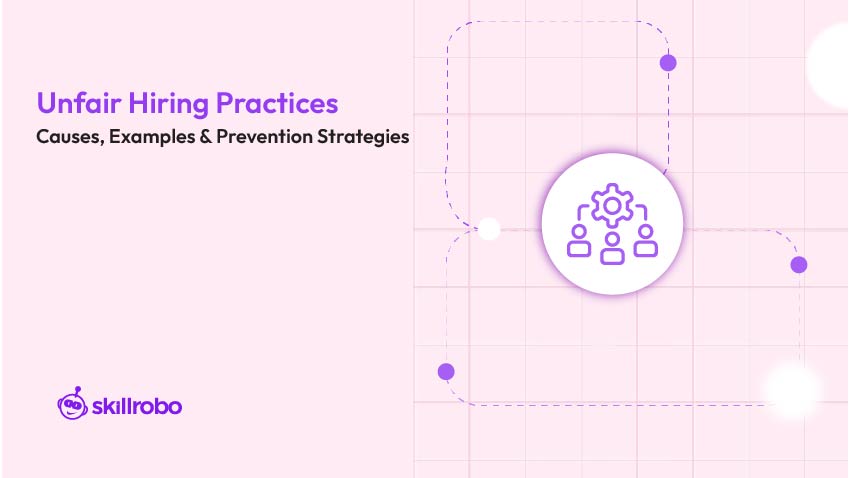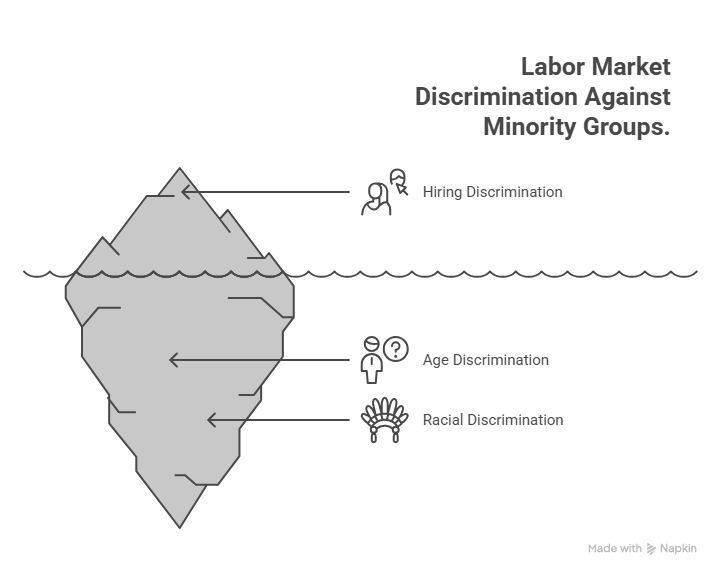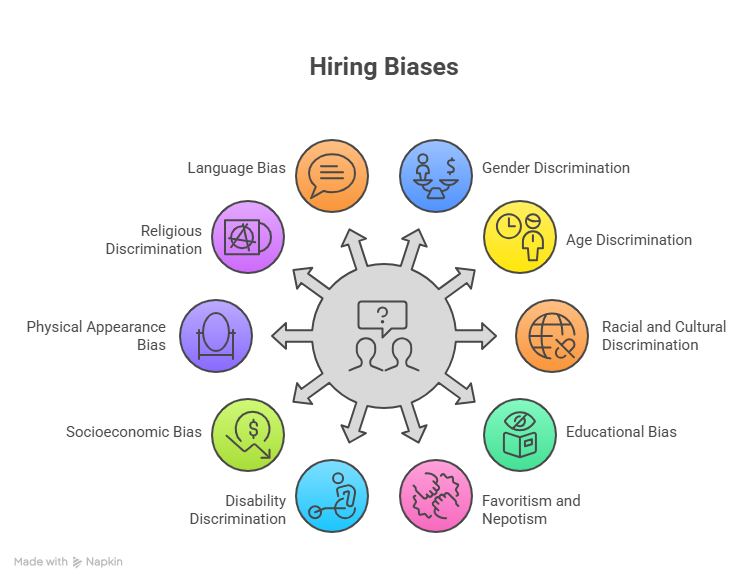Unfair Hiring Practices – Causes, Examples & Prevention Strategies

Key Takeaways
- Unfair hiring practices undermine diversity, transparency, and organizational ethics, leading to poor cultural and performance outcomes
- Hidden or unconscious bias during recruitment impacts objectivity and reduces talent acquisition quality
- Adopting standardized, skill-based, and automated candidate assessment tools ensures fair and merit-driven hiring decisions
- Skillrobo empowers HR teams to eliminate bias, promote inclusivity, and strengthen credibility in the recruitment process
Equal employment opportunity. Diversity and inclusion in hiring. Hiring teams are constantly driving to ensure their hiring practices revolve around these 2 buzzwords. Unfair hiring comes in the way of HR teams working to ensure equal employment opportunities and diversity and inclusion in hiring. Even with advanced HR technology and structured recruitment frameworks, unfair hiring continues to occur.
60% of people aged between 18-34 claim that they have experienced hiring discrimination of some kind due to unfair hiring practices.
Unfair or biased recruitment practices are often rooted in unconscious preferences, inconsistent evaluation criteria, or cultural assumptions that cloud objective judgment. In this blog, we explore what unfair hiring is, why it persists despite awareness, and how HR professionals can prevent it. We also look at Skillrobo, an intelligent pre-employment assessment platform that helps companies create fair, transparent, and unbiased recruitment systems that emphasize merit, not personal preference.
What is Unfair Hiring?
Unfair hiring refers to any recruitment practice that favors or discriminates against candidates based on irrelevant or subjective factors instead of evaluating them solely on their skills, experience, and potential. It may manifest as bias toward a particular gender, ethnicity, or educational background, or even subtle behaviors such as forming opinions based on a candidate’s tone or appearance. According to recent research, many individuals belonging to various minority groups still face considerable discrimination in the labor market.

The consequences of unfair hiring extend far beyond a single bad hire, extending to lost opportunities for candidates and organizations. It affects organizational diversity, damages employer branding, and creates a ripple effect of disengagement among employees. Moreover, candidates who experience discrimination or favoritism during hiring are likely to share their stories publicly, creating reputational damage that can deter top talent from applying in the future.
For instance, an HR manager may unconsciously prefer candidates from their alma mater or perceive certain accents as more “professional.” Although these actions may not be deliberate, they influence the fairness of hiring decisions. According to a 2024 industry report, nearly 64% of job seekers believe they have faced discrimination in the hiring process at least once in their careers.
Unfair hiring not only restricts equal opportunity but also leads to homogeneous work environments lacking creativity and innovation. By contrast, fair hiring ensures organizations attract diverse perspectives that enrich collaboration and drive performance.
Common Forms of Hiring Discrimination in Companies
Hiring discrimination can take many forms, some overt and others subtle. While modern HR teams strive for inclusivity, unconscious biases often influence how candidates are perceived and evaluated. These biases can creep into job postings, resume screening, interviews, and even final offer decisions. Recognizing the various forms of hiring discrimination is the first step toward building a recruitment process that values skill and merit over perception or prejudice.

Below are some of the most common and impactful forms of discrimination observed in today’s hiring landscape:
1. Gender Bias
Gender bias remains one of the most prevalent forms of discrimination in recruitment. It occurs when assumptions about a person’s capabilities are made based on their gender rather than their skills. For example, a company might favor men for technical or leadership positions, assuming they are more assertive, while women may be steered toward administrative or supportive roles.
Even subtle cues in job descriptions, such as using masculine-coded words like “dominant,” “competitive,” or “aggressive”, can discourage female candidates from applying. This bias not only limits opportunities for women but also deprives organizations of diverse leadership perspectives that drive innovation and collaboration.
2. Age Discrimination
Age-related bias affects both younger and older professionals. Many employers overlook older candidates under the assumption that they might lack technological skills or adaptability. On the other hand, younger professionals may be perceived as inexperienced or less reliable.
Age discrimination narrows the talent pool by excluding experienced workers who bring valuable institutional knowledge and mentoring potential. It also prevents younger candidates from proving their capabilities and growing within the organization. A balanced age-diverse workforce enhances decision-making and knowledge sharing, both essential for long-term success.
3. Racial and Cultural Bias
Racial or cultural bias in hiring occurs when candidates are treated differently based on ethnicity, language, or national origin. This often manifests during initial screening stages, where recruiters unconsciously favor applicants with “familiar” names or accents.
A 2023 study found that resumes with names perceived as ethnic were 30% less likely to receive interview invitations than identical ones with Anglo-Saxon names. Such discrimination not only violates equality standards but also robs organizations of multicultural talent that fosters creativity and global competitiveness. Promoting blind resume reviews and inclusive interview training can help reduce these biases.
4. Educational Bias
Educational bias happens when recruiters place excessive importance on the university a candidate attended or the degrees they hold rather than the actual skills or experience they possess. This can lead to excluding highly competent applicants from lesser-known institutions or those who took alternative educational routes such as online programs or certifications.
In a rapidly evolving job market, focusing solely on academic pedigree often results in overlooking candidates with practical, hands-on expertise. Employers should instead emphasize skill-based testing and demonstrable performance over brand-name qualifications.
5. Favoritism and Nepotism
Favoritism and nepotism involve giving preferential treatment to individuals based on personal relationships, referrals, or social connections rather than merit. While referrals can be beneficial for finding reliable candidates, excessive reliance on them can lead to homogenous workforces and exclude external talent with fresh perspectives.
Nepotism not only undermines morale among existing employees but also weakens trust in organizational fairness. Employees who perceive favoritism may feel demotivated or disengaged, leading to higher turnover rates and lower productivity. Implementing transparent evaluation criteria and multiple decision-makers in the hiring process can minimize such risks.
6. Disability Discrimination
Another overlooked form of bias is discrimination against candidates with disabilities. Many recruiters, consciously or unconsciously, assume that individuals with physical or mental disabilities are less capable of meeting job demands, even when accommodations could easily be made.
Organizations that fail to provide equal opportunities or reasonable adjustments for such candidates are not only violating legal requirements but also missing out on highly skilled individuals with unique problem-solving capabilities. A disability-inclusive recruitment process ensures accessibility in applications, interviews, and workplace setups, creating an environment of fairness and respect.
7. Socioeconomic Bias
Socioeconomic bias arises when recruiters unconsciously prefer candidates from privileged backgrounds, assuming they are more “polished” or professional. This can occur through judgments about accents, clothing, or previous employers.
Such assumptions disadvantage capable individuals from less privileged backgrounds who may bring resilience, adaptability, and strong work ethics to the table. Fair hiring should prioritize a candidate’s potential, competence, and learning agility over social appearance or upbringing.
8. Appearance and Weight Bias
Though rarely discussed, appearance-based discrimination is common. Candidates may be judged based on body type, grooming, or attire rather than their professional abilities. Weight bias, in particular, has been shown to impact both hiring decisions and salary offers.
Organizations must ensure that professionalism is assessed based on demeanor, skills, and attitude, not physical traits. Training hiring managers to recognize and challenge such superficial judgments is essential to uphold fairness.
9. Religious Discrimination
Religious bias occurs when recruiters treat candidates differently because of their beliefs, practices, or attire. This may include avoiding candidates who wear certain symbols of faith or requiring employees to conform to specific cultural norms that exclude others.
Such discrimination limits diversity and creates an exclusionary environment. Respecting religious freedom during hiring and allowing accommodations such as flexible schedules for observances ensures equality and strengthens inclusivity.
10. Bias in Job Advertisements and Language
Sometimes discrimination starts even before a candidate applies, within the language of the job post itself. Terms like “digital native” or “recent graduate” can unintentionally exclude older applicants, while gender-coded words influence who feels welcome to apply.
Inclusive job descriptions should focus on responsibilities, skills, and performance expectations. Reviewing job ads through a diversity lens or using inclusive language analysis tools helps attract a broader, more diverse applicant pool.
Discrimination in any of these forms can have lasting effects on both candidates and organizations. It restricts diversity, reduces trust in HR processes, and can expose companies to legal action. More importantly, it undermines the very purpose of recruitment, to find the most capable, skilled, and value-aligned individuals for a role.
Streamline your Pre-employment Assessments with Skillrobo
How to Identify Bias in the Recruitment Process
Identifying bias in recruitment requires both awareness and analytical rigor. HR teams should monitor their hiring data to identify patterns that indicate favoritism or exclusion. Warning signs include a lack of diversity in shortlists, repeated hiring from specific backgrounds, or subjective interview feedback that lacks measurable justification.
Structured evaluations, diverse interview panels, and consistent interview questions help minimize bias. Additionally, blind recruitment, where candidate identifiers such as name, gender, or photo are hidden, ensures that decisions are based purely on skill and performance.
Regular audits of recruitment outcomes also help HR teams pinpoint disparities in hiring decisions and address unconscious patterns before they escalate.
Impact of Unfair Hiring on Workplace Culture
The impact of unfair hiring extends far beyond the recruitment stage. When bias shapes who gets hired, it influences workplace culture, team dynamics, and morale. A lack of diversity leads to groupthink, limited innovation, and disengaged employees.
Candidates who experience unfair treatment often share their experiences online, which can significantly harm an organization’s employer brand. In fact, studies suggest that nearly 70% of candidates avoid applying to companies with negative hiring reviews. Transparent and equitable hiring, on the other hand, fosters trust, loyalty, and higher employee engagement, helping organizations attract better talent and retain them for longer periods.
Legal Consequences of Discriminatory Hiring Policies
Unfair hiring practices can have serious legal implications. Most countries have strict anti-discrimination and equal employment laws that protect candidates from unfair treatment based on race, gender, disability, or age. In the United States, the Equal Employment Opportunity Commission (EEOC) enforces these laws and handles thousands of discrimination complaints each year.
Legal violations can result in lawsuits, heavy fines, and reputational damage that may take years to repair. Even if an organization’s actions are unintentional, the perception of bias can be equally damaging. Therefore, compliance and transparency must be embedded into every recruitment policy and practice.
How HR Can Prevent Unfair Hiring Decisions
Preventing unfair hiring requires a proactive and systematic approach. HR departments must establish clear, consistent, and measurable hiring standards for every role. Job descriptions should reflect skills and outcomes rather than subjective qualities. Interview panels should include members from diverse backgrounds to balance perspectives. A successful strategy to overcome unfair hiring practices is to revisit all the recruitment and hiring practices through the lens of Diversity, Equity, Inclusion, and Belonging ( DEIB).
A Harvard Study reveals that 54% of Native Americans living in majority indigenous areas report facing discrimination in hiring, promotion, and pay.
Training plays an essential role in preventing bias. Conducting regular sessions on diversity awareness, inclusive interviewing, and behavioral evaluation helps hiring teams make objective decisions. Furthermore, organizations should embrace technology-driven assessment tools to measure candidates’ abilities based on performance, not perception.
Steps to Ensure Fairness in Recruitment
To embed fairness in recruitment, organizations must implement structured and transparent processes at every stage. Some essential steps include:
- Define Objective Criteria: Set measurable and role-specific requirements before evaluating applicants.
- Standardize Interviews: Use structured, competency-based questions for all candidates.
- Implement Blind Screening: Remove identifying information from applications to reduce unconscious bias.
- Train Interviewers: Equip hiring teams to recognize and counteract their biases.
- Audit Recruitment Data: Review diversity metrics regularly to identify areas needing improvement.
A consistent, data-backed approach to hiring not only ensures fairness but also strengthens the organization’s commitment to equality and inclusion.
How Technology Can Reduce Hiring Bias
Technology plays a transformative role in reducing hiring bias. AI-powered assessments and analytics provide objective insights into candidate performance, removing the influence of personal judgment. Automation helps maintain consistency by ensuring that every candidate undergoes the same evaluation process.
However, HR teams must ensure that these systems are designed with transparency to avoid algorithmic bias. When used responsibly, technology enhances fairness, supports compliance, and helps organizations make data-driven hiring decisions.
Best Practices for Ethical Hiring and Recruitment
Ethical hiring requires more than compliance, it demands a commitment to respect, transparency, and accountability in every stage of the recruitment journey. Drawing inspiration from workplace equality principles, organizations can cultivate fairness through deliberate action and empathy.
One of the most effective ways to maintain ethics in recruitment is to build inclusion into company culture. Diversity should not be a checkbox but a value reflected in every hiring decision. HR leaders should ensure job descriptions use inclusive language and avoid gender-coded terms that discourage applications from underrepresented groups.
Encouraging open communication also supports fairness. When candidates feel safe discussing experiences of bias or unfairness, organizations gain valuable insights to improve their hiring systems. Creating anonymous feedback channels for applicants and employees allows transparency without fear of retaliation.
Another best practice is to hold leadership accountable for maintaining ethical standards. Managers should lead by example, ensuring that fairness is embedded in both recruitment and career development processes. Documenting hiring procedures and maintaining audit trails help demonstrate compliance and integrity.
Lastly, promote allyship and continuous education within the organization. Regular training on diversity awareness, inclusive interviewing, and unconscious bias ensures that hiring teams are equipped to make objective decisions. Fair hiring is not a one-time effort, it is rather a cultural mindset that must evolve with the organization.
When organizations embed these best practices, they not only prevent discrimination but also foster a workplace where every candidate and employee feels valued and respected.
Unlock the true potential of your workforce
How Skillrobo Promotes Fair and Unbiased Hiring
Skillrobo is designed to empower organizations to build fair, data-driven, and transparent hiring processes. It combines automation, analytics, and intelligent candidate assessments to ensure that decisions are based on measurable skill performance rather than subjective opinions.
By using Skillrobo, HR teams can easily customize assessments for specific roles, evaluate candidates objectively, and generate consistent reports that eliminate bias from the hiring process. It helps recruiters focus on what truly matters, which is the candidate’s ability to perform.
Key Features of Skillrobo for Fair Hiring
- Comprehensive Skill Assessments: Skillrobo enables HR teams to design tests tailored to each job, ensuring fair and accurate evaluation.
- Objective Candidate Evaluation: Automated scoring ensures all candidates are measured using the same standards.
- Bias-Free Screening: The platform removes identifying details from assessments, reducing unconscious bias.
- Data-Driven Insights: Analytics dashboards reveal patterns in hiring outcomes, helping HR identify and address bias.
- Integration With HR Systems: Skillrobo connects seamlessly with existing recruitment tools, streamlining end-to-end hiring workflows.
- Transparent Reporting: Generates audit-ready reports to maintain fairness, compliance, and accountability.
- Enhanced Candidate Experience: Keeps applicants informed throughout the process, reinforcing transparency and trust.
By standardizing evaluations and removing subjectivity, Skillrobo helps organizations hire the right people for the right roles, based solely on capability, not connection.
Wrapping Up
Unfair hiring is more than an ethical issue; it’s a strategic challenge that undermines diversity, innovation, and long-term success. Every organization, regardless of size or industry, must adopt fair hiring practices that promote inclusivity, equality, and respect for talent. By combining structured policies, continuous training, and intelligent assessment tools like Skillrobo, HR teams can ensure a recruitment process grounded in merit, transparency, and accountability.
Skillrobo enables businesses to eliminate bias, enhance objectivity, and make smarter hiring decisions that support both organizational goals and ethical responsibility. A fair hiring process not only attracts better talent but also builds a stronger, more inclusive workplace culture; a culture where every individual has an equal chance to succeed. Sign up for the free demo to know more.
Frequently Asked Questions
1. What are examples of unfair hiring practices?
Unfair hiring practices include favoritism, gender or racial bias, age discrimination, and selecting candidates based on personal preferences rather than professional capability.
2. How can HR identify bias in recruitment?
HR can track diversity ratios, audit candidate evaluation data, and use skill-based testing platforms like Skillrobo to uncover patterns that may indicate bias.
3. Are there legal consequences for unfair hiring?
Yes. Discriminatory hiring practices can result in lawsuits, fines, and penalties under equal employment opportunity laws.
4. Can technology fully eliminate bias in hiring?
Technology can minimize bias by standardizing evaluations and providing data-driven insights, but continuous human oversight is necessary to maintain fairness.
5. How does Skillrobo improve fairness in recruitment?
Skillrobo enhances fairness by automating skill-based assessments, ensuring standardized evaluations, and offering transparent reporting to support merit-based hiring decisions.